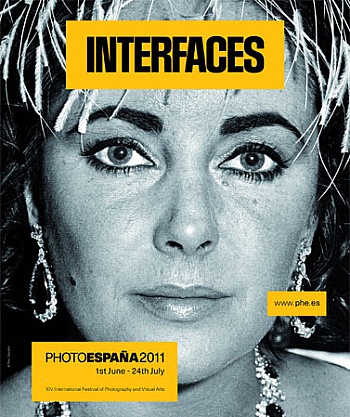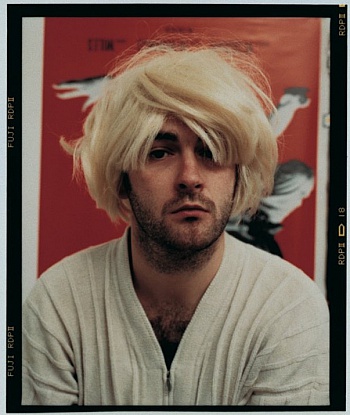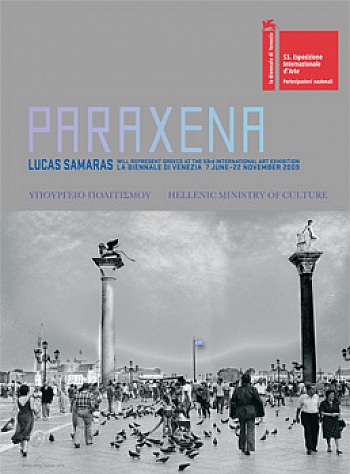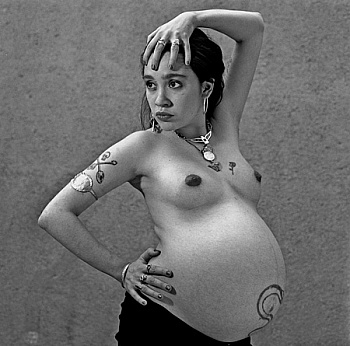Lucas Samaras est né en 1936 à Kastoria en Grèce. Lucas Samaras émigre aux États-Unis en 1948 et est naturalisé américain en 1955. De 1955 à 1962, il fait ses études d’art successivement aux universités Rutgers et Columbia. Sa première exposition personnelle a lieu en 1959. Il vit et travaille à New York.
Festival PhotoEspana 2011 explore le genre du Portrait Exposition Exposition : « Chercher le garçon » au MAC VAL Exposition LA COLLECTION S'EXPOSE - Polaroïd en péril ! Exposition Shake It - Polaroid exhibition at Pump House Gallery Exposition POLAROID exhibition Atlas gallery Exposition Lucas Samaras - Paraxena Exposition A virtual exhibition - TATTOO Modifier l'image
 Du 1er juin au 24 juillet se tiendra à Madrid l'édition 2011 du festival PHotoEspaña, un des plus grands festivals européens dédiés à la photographie (66 expositions, 370 artistes dont Cindy Sherman, Dayanita Singh, Hans-Peter Feldman..., le tout réparti dans 57 lieux) dont le thème est cette année Interfaces: Portraiture and Communication, une exploration du genre du portrait. Nous vous en détaillons ici le contenu. Pour plus d'informations, rendez-vous sur : http://www.phe.es/
The fourteenth annual PHotoEspaña Festival of Photography and Visual Arts will be held in Madrid starting on June 1 through July 24, 2011. In addition to the Spanish capital, there will be other locations hosting Festival exhibitions and activities ...
Du 1er juin au 24 juillet se tiendra à Madrid l'édition 2011 du festival PHotoEspaña, un des plus grands festivals européens dédiés à la photographie (66 expositions, 370 artistes dont Cindy Sherman, Dayanita Singh, Hans-Peter Feldman..., le tout réparti dans 57 lieux) dont le thème est cette année Interfaces: Portraiture and Communication, une exploration du genre du portrait. Nous vous en détaillons ici le contenu. Pour plus d'informations, rendez-vous sur : http://www.phe.es/
The fourteenth annual PHotoEspaña Festival of Photography and Visual Arts will be held in Madrid starting on June 1 through July 24, 2011. In addition to the Spanish capital, there will be other locations hosting Festival exhibitions and activities ... Pour le premier grand rendez-vous de la programmation de l’année de ses 10 ans, le MAC VAL – Musée d’art contemporain du Val-de-Marne présente une exposition thématique pluridisciplinaire.
Qu’est ce qui définit la masculinité aujourd’hui ? Et comment proposer des alternatives à la figure du mâle dominant dans la société patriarcale ?
Pour répondre à ces questions, le commissaire Frank Lamy invite plus de cent artistes hommes, autant de pistes de réflexion autour des modèles culturels de la représentation masculine… de quoi faire tomber certaines idées reçues, aussi tenaces que fragiles. De l’acception de soi et des autres.
Rudas 2. Série «...
Pour le premier grand rendez-vous de la programmation de l’année de ses 10 ans, le MAC VAL – Musée d’art contemporain du Val-de-Marne présente une exposition thématique pluridisciplinaire.
Qu’est ce qui définit la masculinité aujourd’hui ? Et comment proposer des alternatives à la figure du mâle dominant dans la société patriarcale ?
Pour répondre à ces questions, le commissaire Frank Lamy invite plus de cent artistes hommes, autant de pistes de réflexion autour des modèles culturels de la représentation masculine… de quoi faire tomber certaines idées reçues, aussi tenaces que fragiles. De l’acception de soi et des autres.
Rudas 2. Série «... Ansel Adams | Manuel Alvarez-Bravo | Nancy Burson | Walker Evans | Joan Fontcuberta | Gisèle Freund | Luigi Ghirri | Ralph Gibson | Yousuf Karsh | David Levinthal | Sally Mann | Robert Mapplethorpe | Arno Minkkinen | Sarah Moon | Arnold Newman | Helmut Newton | Bill Owens | Bernard Plossu | Bettina Rheims | Lucas Samaras | Stephen Shore | Aaron Siskind | Oliviero Toscani | Andy Warhol | Willliam Wegman.
Durant un demi-siècle, Polaroïd a été synonyme de photographie instantanée. Malgré l'attachement que lui portaient les amateurs comme les professionnels, les films et les appareils Polaroïd ont été victime de la révolution numérique. Avec toutes les consé-quences que cela impliquait pour quantité d'artistes qui a...
Ansel Adams | Manuel Alvarez-Bravo | Nancy Burson | Walker Evans | Joan Fontcuberta | Gisèle Freund | Luigi Ghirri | Ralph Gibson | Yousuf Karsh | David Levinthal | Sally Mann | Robert Mapplethorpe | Arno Minkkinen | Sarah Moon | Arnold Newman | Helmut Newton | Bill Owens | Bernard Plossu | Bettina Rheims | Lucas Samaras | Stephen Shore | Aaron Siskind | Oliviero Toscani | Andy Warhol | Willliam Wegman.
Durant un demi-siècle, Polaroïd a été synonyme de photographie instantanée. Malgré l'attachement que lui portaient les amateurs comme les professionnels, les films et les appareils Polaroïd ont été victime de la révolution numérique. Avec toutes les consé-quences que cela impliquait pour quantité d'artistes qui a... From the lyrics of OutKast’s pop anthem Hey Ya to clues laid out for the amnesiac protagonist in Christopher Nolan’s film Memento, the Polaroid has had a significant impact on contemporary culture. ‘Shake It: An instant History of the Polaroid’ brings to light some of the more intriguing and innovative examples in the history of the Polaroid photograph, exploring its cultural significance and the diversity of its applications. Besides work by some of the most important artists working with the medium, the show will also include Polaroids from other diverse professions and disciplines such as forensics, archaeology, medicine, filmmaking and fashion, as well as those of amateurs and enthusiasts.
Many of the works in this exhibition have never been shown in the UK before, such as David Hock...
From the lyrics of OutKast’s pop anthem Hey Ya to clues laid out for the amnesiac protagonist in Christopher Nolan’s film Memento, the Polaroid has had a significant impact on contemporary culture. ‘Shake It: An instant History of the Polaroid’ brings to light some of the more intriguing and innovative examples in the history of the Polaroid photograph, exploring its cultural significance and the diversity of its applications. Besides work by some of the most important artists working with the medium, the show will also include Polaroids from other diverse professions and disciplines such as forensics, archaeology, medicine, filmmaking and fashion, as well as those of amateurs and enthusiasts.
Many of the works in this exhibition have never been shown in the UK before, such as David Hock... Early last year, the Polaroid Corporation ceased producing its iconic film. The 9th October 2009 will see the final “Use by” or Expiration date of the last batch of Polaroid film manufactured. The exhibition at Atlas will feature a wide selection of Polaroid prints by photographers who have either worked directly with the Polaroid Corporation as part of their research program or who have become famous for the quality of their Polaroid prints either alongside or independent from their traditional camera-based work. It will thus trace the development and use of this unique medium up to the present day. The opening reception will coincide with Polaroid film’s final date of expiration.
The Polaroid or ‘one-step photography’ was invented by Edwin H. Land, founder of the Polaroid Corporati...
Early last year, the Polaroid Corporation ceased producing its iconic film. The 9th October 2009 will see the final “Use by” or Expiration date of the last batch of Polaroid film manufactured. The exhibition at Atlas will feature a wide selection of Polaroid prints by photographers who have either worked directly with the Polaroid Corporation as part of their research program or who have become famous for the quality of their Polaroid prints either alongside or independent from their traditional camera-based work. It will thus trace the development and use of this unique medium up to the present day. The opening reception will coincide with Polaroid film’s final date of expiration.
The Polaroid or ‘one-step photography’ was invented by Edwin H. Land, founder of the Polaroid Corporati... Lucas Samaras represents Greece at the 53rd International Art Exhibition
La Biennale di Venezia
Curated by Matthew Higgs, Lucas Samaras will present the multi-installation "Paraxena" in the Greek Pavilion in the Giardini della Biennale.
The exhibition for the Greek Pavilion brings together works from three recent series (2005-2009) of photographic and video works, juxtaposed with a discrete group of works from the mid 1960s.
The three recent groups of works – from the "Nexus", "Chairs", and "iMovie" series – have not been widely seen outside of the USA, they will be shown alongside a major video installation "Ecdysiast and Viewers" (2006), which is on loan from the collection of the Museum of Modern Art, New York.
The "Chairs" and "...
Lucas Samaras represents Greece at the 53rd International Art Exhibition
La Biennale di Venezia
Curated by Matthew Higgs, Lucas Samaras will present the multi-installation "Paraxena" in the Greek Pavilion in the Giardini della Biennale.
The exhibition for the Greek Pavilion brings together works from three recent series (2005-2009) of photographic and video works, juxtaposed with a discrete group of works from the mid 1960s.
The three recent groups of works – from the "Nexus", "Chairs", and "iMovie" series – have not been widely seen outside of the USA, they will be shown alongside a major video installation "Ecdysiast and Viewers" (2006), which is on loan from the collection of the Museum of Modern Art, New York.
The "Chairs" and "... Tattoo
Curated by Peter Weibel, ZKM
The tattoo, originally "the tatau" ornaments the skin and thus abstracts everyday life. The Tattoo is a masquerade of the skin and marks the body itself as the place of fantasy. Because through the painted body - through the tattoo - the body itself becomes exotic and therefore there is no normal everyday life anymore. Now there is only an exotic and erotic everyday life possible.
To cover the body with signs is like opening a door. A door to paradise, to another place, to an utopian place. The body itself becomes this heterotopos. The body itself becomes this utopian place.
The door of the tattoo leads to the theater of illusions - just think of Genet -, to the theater of desires like in a dream. The door of the tattoo leads to the room of childhood, to t...
Tattoo
Curated by Peter Weibel, ZKM
The tattoo, originally "the tatau" ornaments the skin and thus abstracts everyday life. The Tattoo is a masquerade of the skin and marks the body itself as the place of fantasy. Because through the painted body - through the tattoo - the body itself becomes exotic and therefore there is no normal everyday life anymore. Now there is only an exotic and erotic everyday life possible.
To cover the body with signs is like opening a door. A door to paradise, to another place, to an utopian place. The body itself becomes this heterotopos. The body itself becomes this utopian place.
The door of the tattoo leads to the theater of illusions - just think of Genet -, to the theater of desires like in a dream. The door of the tattoo leads to the room of childhood, to t...